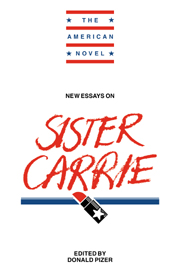Book contents
- Frontmatter
- Contents
- Series Editor's Preface
- Note on the Text
- 1 Introduction
- 2 Carrie's Blues
- 3 A Portrait of the Artist as a Young Actress: The Rewards of Representation in Sister Carrie
- 4 Sister Carrie: The City, the Self, and the Modes of Narrative Discourse
- 5 Who Narrates? Dreiser's Presence in Sister Carrie
- Notes on Contributors
- Selected Bibliography
3 - A Portrait of the Artist as a Young Actress: The Rewards of Representation in Sister Carrie
Published online by Cambridge University Press: 05 June 2012
- Frontmatter
- Contents
- Series Editor's Preface
- Note on the Text
- 1 Introduction
- 2 Carrie's Blues
- 3 A Portrait of the Artist as a Young Actress: The Rewards of Representation in Sister Carrie
- 4 Sister Carrie: The City, the Self, and the Modes of Narrative Discourse
- 5 Who Narrates? Dreiser's Presence in Sister Carrie
- Notes on Contributors
- Selected Bibliography
Summary
THE history of Sister Carrie has long been informed by contradictory, sometimes apocryphal accounts of the novel's composition and publication. When asked about his work on Sister Carrie, Dreiser himself tended to stress the “mystic” component in his writing process. He often described his sense of having been “used … like a medium,’ when he wrote the first words of the text, and of finishing the manuscript with the help of “inspiration” that came “suddenly … of its own accord,’
While writing Sister Carrie, however, Dreiser evolved certain habits of composition which significantly complicate the image of autonomous inspiration that he later fostered. Like Carrie's first public appearance on stage, Dreiser's first attempt to write a novel was facilitated by the intensive mediation of other people. Indeed, the sustained involvement of friends, lovers, readers, and editors was indispensable to Dreiser's fiction writing all his life.
Dreiser's long-standing emphasis on his solitary moments of creative inspiration is especially interesting in the context of the collaborative process that informed the composition of Sister Carrie. Throughout that process, Dreiser's wife, Jug, and his friend Arthur Henry made myriad suggestions, emendations, and excisions, large and small.
- Type
- Chapter
- Information
- New Essays on Sister Carrie , pp. 43 - 64Publisher: Cambridge University PressPrint publication year: 1991
- 1
- Cited by

